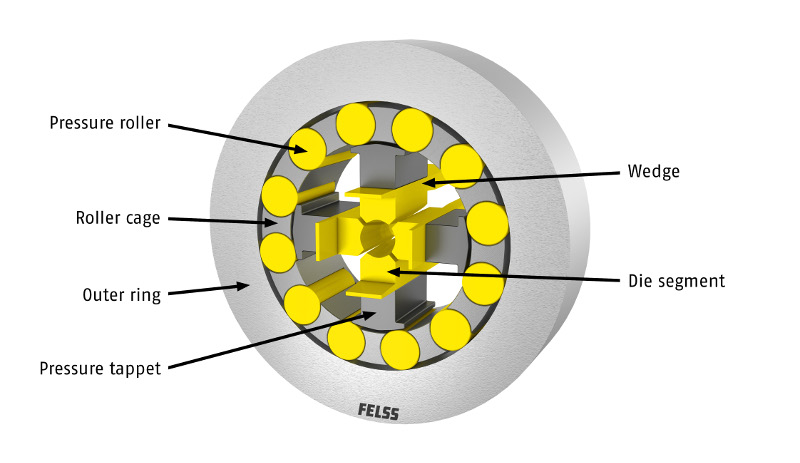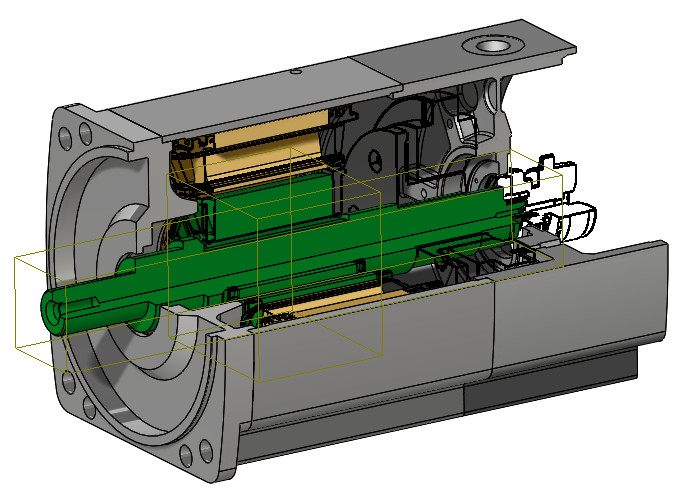Simulation On The Test Bench
When developing their new machine generation, the Felss Group worked together closely with the drive specialist Baumüller. As part of the project, Baumüller tested the current possibilities of drive simulations. The result will affect the future approach.
The globally active Felss Group develops machines and processes in the field of forming technology and faced a challenge with its new machine “generation e.” The machines for cold forming components through rotary swaging were converted from hydraulic to electrical drive technology, which resulted in a high vibration load on the engine, tremendously shortening the drive's service life. In the process of rotary swaging, several die segments act upon a workpiece in rapid succession, recasting it with high precision in this way | Fig.: Felss
In the process of rotary swaging, several die segments act upon a workpiece in rapid succession, recasting it with high precision in this way | Fig.: Felss
The application
Rotary swaging involves reducing tubes, wires, and rods through a process in which several dies working against each other exert compressive forces on the workpiece in a radial direction. During this, recasting is done through a number of quickly applied pressure impulses.
To achieve a high degree of precision in the inner diameter and the thickness of the wall, recasting is done by a mandrel that is inserted into the workpiece, as can be seen in figure 2. This mandrel transmits the vibrations induced by the process directly to the drive, which has a considerable impact on the service life of the drive.
The challenge
Felss already contacted Baumüller with this drive mechanism challenge at an early stage of the product development process. In close cooperation between machine manufacturer and drive specialist, the goal was to achieve the key requirements for process reliability and optimization of resource efficiency. Baumüller chose the compact servomotor DSC1-100 to insert the mandrel into the swager in the axial direction via a spindle drive so that the workpiece has radial support.
The vibrations that occurred as a result of the workpiece’s oscillation were transmitted to the motor through the spindle. The consequence was damage to the bearings, which led to early motor failure. This means the best downtime for the Baumüller motor – just a few weeks, but far from enough.
The calculation
 Contacts and their characteristics are realistically simulated for modeling the motorTo determine the vibration height, measurements were performed on the machine with a Baumüller standard motor. The parameters received were then used as the basis for the simulation so that the motor was virtually stressed with the actual vibrations.
Contacts and their characteristics are realistically simulated for modeling the motorTo determine the vibration height, measurements were performed on the machine with a Baumüller standard motor. The parameters received were then used as the basis for the simulation so that the motor was virtually stressed with the actual vibrations.
As a specialist with decades of expertise in electric drive technology, Baumüller was able to model the motor with all the relevant features. Information regarding material, contacts, and connection types were incorporated here. The components ruled out by the analysis were factored in through remote masses with the respective mass inertia values.
The calculation model revealed that the motor is exposed to higher axial stress from vibrations. According to the calculations, it appears that the service life could theoretically increase from a few hundred hours to over 50,000 hours with the presumed stress load if two angular contact ball bearings were used instead of the standard deep groove ball bearings. Thus suitable action could be chosen even before physical testing, and a statement could be made about the effectiveness of the action.
The testing
A prototype was made based on the calculations, and was tested on the test bench. The calculated values and the values measured during the endurance test were then compared. The results were consistent over 90% of the time. The good results were able to be confirmed again in a field test. Thus the cause of failure could be eliminated and the motor could be awarded the rating “fatigue resistant” for this application decision.
Conclusion
Modeling motors for calculation purposes seems complicated at first. The level of consistency between the calculation and the test of over 90% shows, however, that calculations map the actual stress loads very well. For this reason, simulations with modeled motors should be viewed as true alternatives to prototype building, with distinct possibilities for optimization. With these new methods, Baumüller makes it possible to save time and costs and creates spatial independence, which is more frequently needed in the age of globalization, digitalization, and networking. Modeling motors and simulating drives will expand Baumüller’s product range as new services.
Write us a message, our sales experts will be happy to advise you.